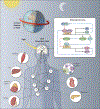Circadian Mechanisms in Medicine
- PMID: 33567194
- PMCID: PMC8108270
- DOI: 10.1056/NEJMra1802337
Circadian Mechanisms in Medicine
Figures



Comment in
-
Circadian Mechanisms in Medicine.N Engl J Med. 2021 May 20;384(20):e76. doi: 10.1056/NEJMc2104154. N Engl J Med. 2021. PMID: 34010542 Free PMC article. No abstract available.
-
Circadian Mechanisms in Medicine.N Engl J Med. 2021 May 20;384(20):e76. doi: 10.1056/NEJMc2104154. N Engl J Med. 2021. PMID: 34010543 No abstract available.
References
Publication types
MeSH terms
Grants and funding
LinkOut - more resources
Full Text Sources
Other Literature Sources
